Deep Focus: The Lion King
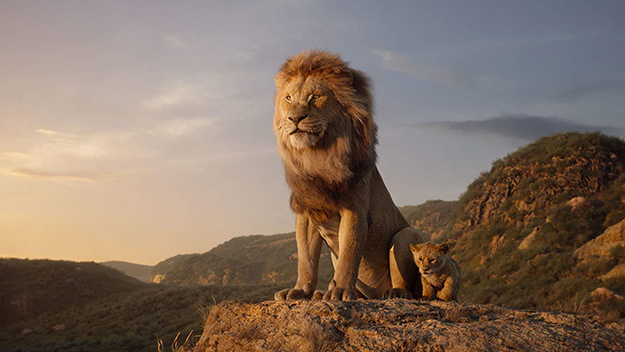
Images from The Lion King (Jon Favreau, 2019)
When we think of George Miller’s glorious Babe diptych, do we immediately recall how the hero’s mouth moved? No, that’s the last thing we think about because our memories are awash in the director’s robust comic vision of an empathetic young pig bringing city and country together via his Lancelot-like courage and purity of heart.
Lip motion may be the main thing we remember about Jon Favreau’s dutiful remake of The Lion King. Even as a cub, Simba speaks effortlessly, with each facial muscle making its own micro-adjustment to every attempt at humor or poignancy. As we’ve learned from advance publicity (and the kind of press that might as well be publicity), Favreau directed his voice actors as real performers on a black-box-theater soundstage rather than as speakers at a music stand. It supposedly enabled them to inhabit characters from claws to mane, so the digital attendants could meld their human demeanor to the correct mammal postures, but in effect they come off as zoo specimens with intermittent flickers of anthropomorphic personality.
This prosaic wizardry might still be impressive if there were conviction or originality behind the scene-making. Unfortunately, from mandrill Rafiki introducing Baby Simba (JD McCrary) to the gathered herds and flocks, to Rafiki and Adult Simba (Donald Glover) presenting his infant son to the same animal kingdom, there’s a been-there, sung-that feeling to the would-be bedazzlement. Not even ace cinematographer Caleb Deschanel, working with tools that empower him to navigate and light a virtual set as if it were a location, can provide Favreau’s production and Jeff Nathanson’s script with the ingredient they so desperately need: a novel, vital concept.
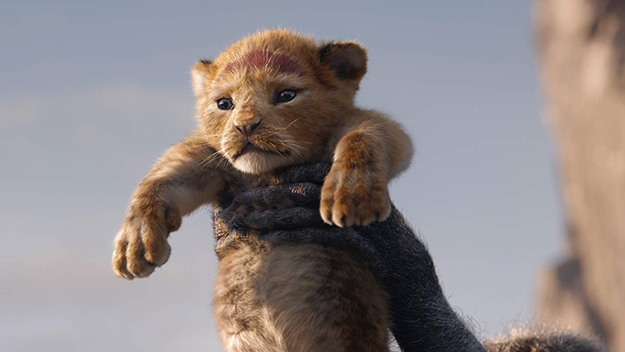
The film has been angled to Lion King zealots: it’s a lavish excuse to experience it again, if not, alas, afresh. Beyoncé (who plays Simba’s grownup fiancée Nala) and Elton John and Tim Rice (who wrote the original score) contribute bland new inspirational tunes. Otherwise, this movie could be presented as an instant sing-along. The audience comes alive only when key moments hit the nostalgia button: the cry from the wild savanna before “The Circle of Life;” the sight of grown Simba (Donald Glover), meerkat Timon (Billy Eichner), and warthog Pumbaa (Seth Rogen) parading in front of the moon; and the first infectious beats of the Tokens’ 1961 #1 hit, “The Lion Sleeps Tonight,” which is the sole cue that hit home for me.
The Lion King was already an opportunistic grab bag as a 1994 2-D cartoon musical. It was common knowledge a quarter-century ago that the filmmakers cobbled together elements from sources as diverse as Disney Vault items and Shakespeare. (Then there’s the disputed influence of the Japanese cartoon series, Kimba the White Lion.) “Simba” derives from Swahili for “lion,” but it’s also just one letter removed from an anagram for “Bambi”: they must have been tempted to go all the way and call their hero “Bimba.” Scar’s assassination of King Mufasa (James Earl Jones), his brother and Simba’s noble, loving dad, mirrors the hunter killing Bambi’s mother, who was, we should note, the mate of the Great Prince of the Forest. Simba’s confrontation with a homicidal uncle echoes Hamlet. (The name of Simba’s uncle was meant to refer to the vertical pink scar over and under his left eye, but in Favreau’s version, the scar is almost invisible, because it’s as colorless as Chiwetel Ejiofor’s performance.) And Simba’s years in exile recall the Biblical stories of Joseph and Moses.
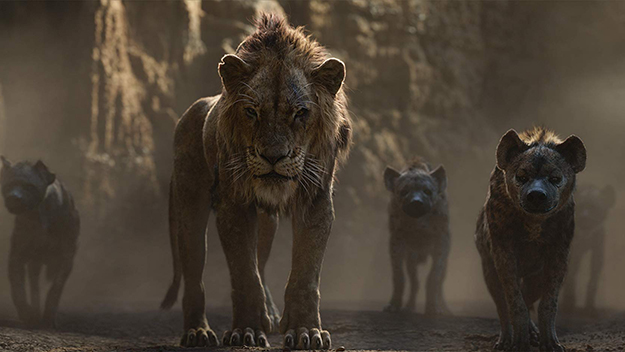
The Lion King draws even more significantly on a literary classic that Disney animators and Favreau already sugared up beyond recognition: Kipling’s The Jungle Book, which also contains a disfigured big cat, a Bengal tiger, as a villain and a scavenger animal—a jackal—as his ally. True to the gumdrop aspirations of those films, neither the animators of Disney’s 1967 The Jungle Book nor Favreau in his 2016 CGI retread include the jackal. Favreau, wrongheadedly, must see The Lion King as a fiercer beast. He goes all out with Scar’s hyena army.
This film’s plodding naturalism italicizes the mayhem in ways that throw the story out of whack and the audience off-kilter. Traditional animators got away with the manic-depressive scenario 25 years ago thanks to their slashing stylization and vaudevillian concept of cartoon performance. Audiences in 1994 recognized Scar as both a dastardly lion and as Jeremy Irons in his Claus von Bülow mode (just as Wizard of Oz audiences in 1939 knew the Cowardly Lion was Bert Lahr). Scar even repeated Irons’ signature retort from Reversal of Fortune, the haughty and ominous, “You have no idea”—a zinger that in the new film loses all its zing. The old-school cartoonists’ gusto and embrace of artifice made it easier for audiences to segue from Scar’s diabolical plotting to Simba’s ecstatic discovery of a jungle paradise. Here, when Scar digs into Mufasa’s hands as the monarch hangs from a cliff, propelling him into a wildebeest stampede, it plays like a cross between an episode of National Geographic’s Savage Kingdom and a Die Hard film. During a homicidal chase, the hyenas’ grotesque faces barrel into closeups like Jason or Freddy in a “gotcha!” moment.
In this photo-real context, the “Circle of Life” registers more incongruously than ever as a bland attempt to simplify and tenderize Kipling’s “Law of the Jungle,” heightening the urtext’s inconsistencies. When Simba asks his towering dad how eating antelope jibes with kingly talk about respecting creatures great and small, Mufasa explains, in Jones’s stirring, earthy tones: “When we die, our bodies become the grass, and the antelope eat the grass. And so we are all connected to the great Circle of Life.” I realize Mufasa is supposed to maintain “a delicate balance” to protect the Pride Lands’ ecology. But even if we grant this movie its donnée, should we accept the premise that antelope and zebra would swarm to Pride Rock to stomp out gratitude for a future king who might devour them? I prefer to think they’re dancing on the grass that contains the previous lion kings’ remains. (The lion kings’ spirits, of course, rise to the stars, where they watch over Simba.)
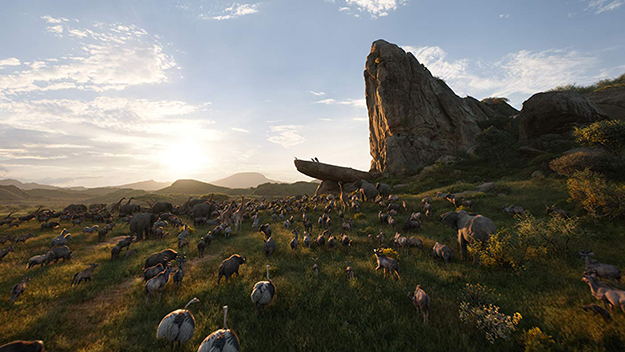
The Oscar-winning prom-night favorite “Can You Feel the Love Tonight?” helped make the first film and the John-Rice score a hit. “Hakuna Matata” (“No Worries”), though, provides the truest entertainment in both movies. It comes in the mostly merry midsection. Scar succeeds at guilt-tripping Simba into believing he’s responsible for his father’s death. But the hyenas can’t pull off Scar’s planned coup de grace: Simba’s death. Simba gets away but collapses in a desert, where Timon and Pumbaa rescue him from vultures. The meerkat and the warthog drag him into the joys of their slacker life in a jungle that features a bottomless bug buffet. (Scarfing down insects doesn’t raise any ethical issues.) Some say this sequence obscures the movie’s thrust toward Simba fighting his way toward maturity. Actually, it acknowledges that a traumatized youth might need a break before taking on responsibilities. Eichner and Rogen click with each other and with roles first played by Nathan Lane and Ernie Sabella. Eichner, for once, is more chirrupy than abrasive, and Rogen’s slobbery warmth generates more laughs than Pumbaa’s flatulence.
Sadly, the rest of the movie centers on Simba re-connecting with the now womanly Nala, who inspires him to take up Mufasa’s mantle. This buildup to the climactic clash between Simba and Scar fails on the basic level of animal chemistry. Simba looks like a chip off the old block, but he hasn’t inherited James Earl Jones’s authoritative voice: Glover registers as a kid auditioning to be king, not the rightful heir to Pride Rock. Nala looks just as impersonally handsome as the other lionesses in the movie, and Beyoncé’s manner of speech lacks any hint of spontaneity. (McCrary and Shahadi Wright Joseph strike more playful sparks when Simba and Nala are just cubs.) Glover and Beyoncé don’t mesh with the other actors or each other. To be fair, Favreau offers scant help: they basically swap lines and glances while gamboling through wetlands. (At least when the earlier film introduced “Can You Feel the Love Tonight,” it boasted choreography insane enough for Flying Down to Rio.) Timon and Pumbaa’s third-act return gives the film a shot in the arm that’s too little, too late.
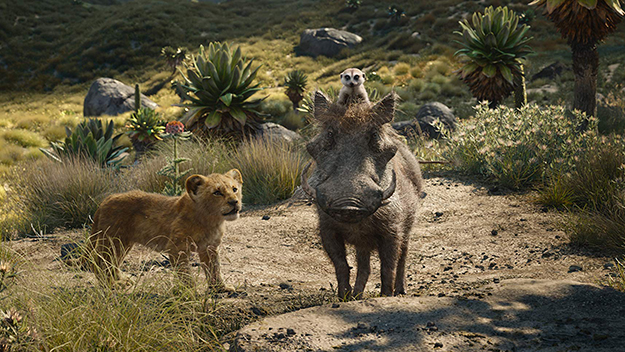
And as good as Eichner and Rogen are, I can more easily summon the look of the 2-D animated meerkat, warthog, and, especially, the mandrill—with the bright blocks of red, blue, and brown that turn its face into a jaunty mask—than the CGI critters, whose features are far less distinct. Favreau and the animation team haven’t reckoned with how much visible emotion they lose by striving after dumb believability. For a more effective and profound display of digital techniques, watch Andy Serkis’s The Jungle Book movie, Mowgli: Lord of the Jungle (2018). Produced simultaneously with Favreau’s The Jungle Book and released two years later on Netflix, Serkis’s use of motion capture soars beyond mere re-creation. Serkis audaciously bends the animals’ facial contours to fit the actor’s personalities: their portraits resemble the haunting, witty illustrations of classic storybook artists like Arthur Rackham or John Tenniel. Black panther Bagheera’s eyes and brow reflect Christian Bale’s rapier intelligence and sympathy, just as Serkis’s own expansive, tragicomic sensibility fills the outsize profile of Baloo the bear. The result taps our desire to suspend disbelief willingly rather than have all the imaginative work done for us. Favreau aims for a similar intensity in The Lion King, but feels even more obeisant to the conventions of digital “realism” than his own Jungle Book.
The half hour padded onto the running time, the weight of the production, and the hubris of its technological aspirations accent the story flaws that were always part of The Lion King. This is one Disney fable that should have stayed a handmade tale.
Michael Sragow is a contributing editor to Film Comment and writes its Deep Focus column. He is a member of the National Society of Film Critics and the Los Angeles Film Critics Association.







